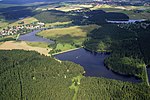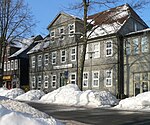Upper Harz

The Upper Harz (German: Oberharz, pronounced [ˈoːbɐhaːɐ̯ts]) refers to the northwestern and higher part of the Harz mountain range in Germany. The exact boundaries of this geographical region may be defined differently depending on the context. In its traditional sense, the term Upper Harz covers the area of the seven historical mining towns (Bergstädte) - Clausthal, Zellerfeld, Andreasberg, Altenau, Lautenthal, Wildemann and Grund - in the present-day German federal state of Lower Saxony. Orographically, it comprises the Harz catchment areas of the Söse, Innerste and Grane, Oker and Abzucht mountain streams, all part of the larger Weser watershed. Much of the Upper Harz area is up to 700 metres (2,300 ft) above sea level. In a wider sense, it also comprises the adjacent High Harz (Hochharz) range in the east, climbing to over 1,100 m (3,600 ft) in the Brocken massif.
Excerpt from the Wikipedia article Upper Harz (License: CC BY-SA 3.0, Authors, Images).Upper Harz
Mönchstalweg, Harz (LK Goslar)
Geographical coordinates (GPS) Address Nearby Places Show on map
Geographical coordinates (GPS)
| Latitude | Longitude |
|---|---|
| N 51.816666666667 ° | E 10.366666666667 ° |
Address
Mönchstalweg
Mönchstalweg
38707 Harz (LK Goslar)
Lower Saxony, Germany
Open on Google Maps










